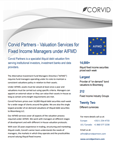ARE THERE MORE EFFICIENT WAYS TO VALUE ILLIQUID ASSETS AT YEAR-END?
Dublin, Ireland – As institutional investors begin to wind down at this time of year, the annual push for year-end valuations begins. For many, year-end valuations are still a key measurement of performance and are directly linked to compensation. This process has become increasingly challenging in recent years: A continuous fall-off in liquidity over the last decade has seen the process of valuing off-the-run securities become increasingly complex and inaccurate at the end of the year.
When it comes to valuing illiquid fixed income securities, we look at more efficient ways of valuing hard to price assets at year-end.
IT’S ALL ABOUT TIMING
When valuing an asset for the purposes of marking performance, the typical goal is to calculate a price that the asset would trade at under normal market conditions. This can be particularly challenging for an illiquid asset with little or no trading history. In most of these cases, a properly documented pricing model is used. Pricing models will vary depending on the structure of the asset. Each model will have well defined inputs and each data input will be reviewed for accuracy and relevance. Adjustments can be made for trade size and timeframe. Under regulation such as AIFMD, final approval of the valuation is provided by parties not linked directly to the front office team involved in the trade. So far, so normal. The challenge here is the time of year.
Year end is anything but normal. It is historically one of the most illiquid periods of the year. Managers and traders are out of the office and even if they are contactable, nobody wants to take on new risk at the end of the year. Liquidity in all markets is lower than normal and as you approach December 31st there is a growing difference in the price of a trade that settles before January 1st and the same trade settling after January 1st.
In this environment, managers are expected to make assumptions about the price their illiquid assets will achieve in the marketplace. Data inputs will be gathered from an illiquid market and market liquidity assumptions are made under far from normal conditions. The idea that accurate valuations can be calculated based on the market conditions in the final working days of a calendar year is simply flawed. Yet many market participants continue to mark their performance to this date.
One simplified way of demonstrating the changes in market liquidity is to look at bond issuance. In the table below, we see that corporate bond issuance in the US and total bond issuance in Europe typically see major drop offs in December, followed by a surge of issuance in the following January. This drop in activity is repeated in primary and secondary markets all over the globe.
| US Corporate Bond Issuance | European Bond Issuance | |||||
| Nov | Dec | Jan | Nov | Dec | Jan | |
| 2016 | $81 bn | $46 bn | $184 bn | €100 bn | €54 bn | €284 bn |
| 2015 | $105 bn | $57 bn | $134 bn | €163 bn | €77 bn | €222 bn |
| 2014 | $119 bn | $59 bn | $96 bn | €146 bn | €77 bn | €209 bn |
Source: Bloomberg
THE SOLUTION TO THE YEAR-END VALUATIONS CONUNDRUM
Investors in illiquid assets tend to have extended holding periods. The assets themselves are valued a couple of times a year at most and quite often, only once a year, at year end. We believe that where an asset is expected to be held beyond year end, that an alternative, more liquid valuation date be used for illiquid asset valuations. To provide investors with valuations under normal market conditions, the process must be carried out under normal market conditions. Luckily, the months of November and January are typically liquid and stable.
At Corvid Partners, we provide market based valuations to a wide range of clients on a wide range of assets. In recent years we have seen clients taking steps to move away from year end valuations. Some have moved valuation dates to November while others have taken the approach of valuing assets on two or more dates either side of year end and using a weighted average price or worst price approach.
Making these changes can take some effort: For funds, it can require changes in fund documentation and board approval. However, managers are going to these lengths to address the issue of illiquid security valuations, demonstrating how important the topic has become to investors in recent times.
Whether it’s moving a single pricing date or taking average pricing over a short period of more liquid market activity, we at Corvid believe that a pragmatic approach to year-end valuations in what for many is an increasing portion of their portfolios is a sensible and important approach to improve reporting accuracy.
For more information, visit corvidpartners.com or click here to contact us directly




